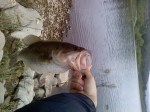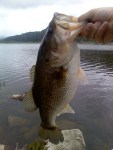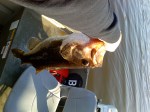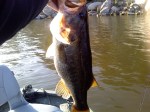Catch and Release Tips
September 23, 2010 3 Comments
Since I mostly practice and advocate catch and release I thought I’d post these tips. Most experienced anglers know these but it never hurts to review them from time to time.
Use artificial baits, not live bait.
Fish are often hooked deeper on live bait then on artificials.Use barbless hooks for catch and release fishing.
You can also bend down the barb of a regular hook. Barbless hooks do less damage to the fish you catch and allow you to release it easier.Set the hook as quickly as possible.
Letting the fish take the bait will give it time to swallow it. As soon as you feel the bite the fish has the bait in its mouth in most cases.Land the fish as quickly as possible.
The longer you fight a fish the more lactic acid builds up in its body and the less likely it is to survive. Use heavy line and tackle to help you land them quickly. If you plan on practicing catch and release, ultralight tackle is not the best way to go. The exception to this rule is when you catch fish in deep water. In that case bring them in slowly to allow them to adjust to the pressure change. If they float belly up when you try to release them they have an inflated swim bladder. In that case use a needle to deflate the bladder or better, use a line with a weight and a tiny hook to take the fish back to deeper water. When you pull hard the small hook will come out if barely hooked in the skin of the lip.Don’t use a net when landing fish.
Nets damage the fish so don’t use one if you can land the fish you catch if you are planning on releasing it. If you have to use a net, a rubber or cotton net is better than a nylon net because they will do less damage.Wet your hands when touching fish.
Dry hands will damage the slime on fish that helps protect them, as well as damaging skin and scales.Keep the fish in the water.
If you can take the hook out of the fish without taking the fish out of the water catch and release is much more successful. If you need to take pictures or measure the fish keep it near the water and put it back in the water as quickly as possible.Don’t hold the fish in the gills or eyes and don’t bend the jaw.
Don’t squeeze the fish tightly. You can damage eyes and gills with your hands and if you hold a fish by the lower jaw and bend it, for example holding a bass up by the lower lip and turning it sideways for a picture, you can damage the jaw so badly the fish can’t feed.Keep the fish off the ground and boat deck.
If it flops around on the ground or boat it can damage itself.Don’t pull a hook out of a fish.
If a fish is hooked deeply, use pliers or a hook removal tool to back the hook out the way it went in. If the hook is deep in a fish’s throat or in its gills, cut the line and leave the hook in it. Cut the line just outside the mouth of the fish.Don’t use stainless steel hooks.
If you have to leave the hook in a fish that is hooked deeply, regular hooks will rust fairly quickly, stainless steel hooks will not.Hold the fish in the water until it starts to move on its own.
Hold it under the belly and keep it upright. Keep its head pointed away from the side of the boat or anything else it might hit as it swims off. Some say move the fish back and forth in the water to move water over its gills, others say don’t do this, it can damage the gills. In current, face the fish upstream into the current.
If you can think of any others let me know!






